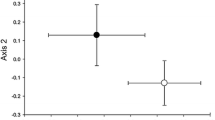Abstract
The terpenoid content of eastern hemlock (Tsuga canadensis) foliage was measured over an annual cycle of development from bud opening, shoot elongation, shoot maturation, to bud-break at the start of the next growing season. The objective was to determine if variation in terpenoid composition is linked with spatial and temporal feeding preferences of the hemlock woolly adelgid (HWA; Adelges tsugae). The HWA has two periods of feeding over the course of 1 yr spanning two complete generations. There are two periods of feeding separated by a nonfeeding period where the adelgid estivates. HWA prefers to feed on mature, rather than young, expanding tissue. Feeding occurs in the leaf cushion at the base of the needle. The needle is the only tissue in hemlock with resin canals that store terpenoids. The needle and leaf cushion of both the current and previous years’ growth were analyzed separately over a 1-yr period to examine the variation of terpenoid composition in space and time. Terpenoids were quantified by using headspace solid-phase microextraction/gas chromatography/mass spectrometry (SPME/GC/MS). New growth needles and leaf cushions do not resemble the previous year’s growth either visually or in chemical composition until October/November, when the adelgid breaks estivation and begins feeding. Nearly all of the 23 terpenoids present exceeding 0.1% varied significantly either temporally or spatially, usually with complex interactions. Ordination and factor analysis revealed that terpenoids are less variable in mature leaf cushions than in young tissue. By entering a nonfeeding diapause during the late spring and summer, HWA avoids the unstable, variable levels of terpenoids in the immature leaf cushion and needles.



Similar content being viewed by others
References
Adams, R. P. 2001. Identification of Essential Oil Components by Gas Chromatography/Quadrupole Mass Spectroscopy. Allured, Carol Stream, IL.
Back, E. L. 2002. Pattern of parenchyma and canal resin composition in softwoods and hardwoods. J. Wood Sci. 48:167–170.
Bowers, W. S., Nishino, C., Montgomery, M. E., Nault, L. R., and Nielson, M. W. 1977. Sesquiterpene progenitor, germacrene A: An alarm pheromone in aphids. Science 196:680–681.
Broeckling, C. D. and Salom, S. M. 2003. Volatile emissions of eastern hemlock, Tsuga canadensis, and the influence of hemlock woolly adelgid. Phytochemistry 62:175–180.
Bruce, T. J., Birkett, M. A., Blande, J., Hooper, A. M., Martin, J. L., Khambay, B., Prosser, I., Smart, L. E., and Wadhams, L. J. 2005. Response of economically important aphids to components of Hemizygia petiolata essential oil. Pest Manag. Sci. 61:1115–1121.
Bryant, D. G. 1974. Distribution of first instar nymphs of Adelges piceae (Homoptera: Phylloxeridae) on branches of balsam fir, Abies Balsamea, after colonization. Can. Entomol. 106:1075–1080.
Farjon, A. 1990. Pinaceae. Drawings and Descriptions of the Genera Abies, Cedrus, Pseudolarix, Keteleeria, Nothotsuga, Tsuga, Cathaya, Pseudotsuga, Larix, and Picea, p. 330. Koeltz Scientific Books, Konigstein.
Francis, F., Vandermoten, S., Verheggen, F., Lognay, G., and Haubruge, E. 2005. Is the (E)-β-farnnesene only volatile terpenoid in aphids? J. Appl. Entomol. 129:6–11.
Harrewijn, P., van Oosten, A. M., and Piron, P. G. M. 2001. Natural Terpenoids as Messengers: A Multidisciplinary Study of their Production, Biological Functions, and Practical Applications, p. 440. Kluwer Academic Publishers, Dordrecht.
Jackson, D. L., Jarosik, V., and Dixon, A. F. G. 1996. Resource partitioning and tolerance of monoterpenes in four species of spruce aphid. Physiol. Entomol. 21:242–246.
Lagalante, A. F. and Montgomery, M. E. 2003. Analysis of terpenoids from hemlock (Tsuga) species by solid-phase microextraction/gas chromatography/ion-trap mass spectrometry. J. Agric. Food Chem. 51:2115–2120.
McClure, M. S. 1987. Biology and control of hemlock woolly adelgid. Conn. Agric. Exp. Stat. Bull. 851:3–9.
McClure, M. S. 1991. Density dependent feedback and population cycles in Adelges tsugae (Homoptera: Adelgidae) on Tsuga canadensis. Environ. Entomol. 20:258–264.
McClure, M. S., Salom, S. M., and Shields, K. S. 2001. Hemlock Woolly Adelgid. USDA Forest Service. FHTET-2001-03, pp 1–19.
Miles, P. W. 1987. Feeding process of Aphidoidea in relation to effects on their food plants, pp. 321–339, in A. K. Minks, and P. Haarewign (ed.). Aphids, Their Biology, Natural Enemies, and Control. Elsevier, Amsterdam.
Miles, P. W. 1990. Aphid salivary secretions and their involvement in plant toxicases, pp. 131–147, in R. K. Cambell, and R. D. Eikenbary (ed.). Aphid–Plant–Genotype Interactions. Elsevier, New York.
Nealis, V. G. and Nault, J. R. 2005. Seasonal changes in foliar terpenes indicate suitability of Douglas-fir buds for western spruce budworm. J. Chem. Ecol. 31:683–969.
Shields, K. S. and Hirth, R. T. 2005. Bacterial endosymbionts of Adelges tsugae Annand: Potential targets for biocontrol? pp. 357–359, in B. Onken, and R. Reardon (eds.); February 1–3, 2005; Ashville, NC. FHTET-2005-01. USDA Forest Service.
Stephan, B. R. 1987. Differences in the resistance of Douglas fir provenances to the woolly aphid Gilletteella cooleyi. Silvae Genet. 36:76–79.
Young, R. F., Shields, K. S., and Berlyn, G. P. 1995. Hemlock woolly adelgid (Homoptera: Adelgidae): Stylet bundle insertion and feeding sites. Ann. Entomol. Soc. Am. 88:827–835.
Acknowledgment
This work was funded by the USDA, U.S. Forest Service (02-CA-11242343-092).
Author information
Authors and Affiliations
Corresponding author
Rights and permissions
About this article
Cite this article
Lagalante, A.F., Lewis, N., Montgomery, M.E. et al. Temporal and Spatial Variation of Terpenoids in Eastern Hemlock (Tsuga canadensis) in Relation to Feeding by Adelges tsugae . J Chem Ecol 32, 2389–2403 (2006). https://doi.org/10.1007/s10886-006-9166-0
Published:
Issue Date:
DOI: https://doi.org/10.1007/s10886-006-9166-0




